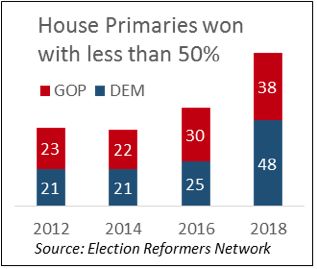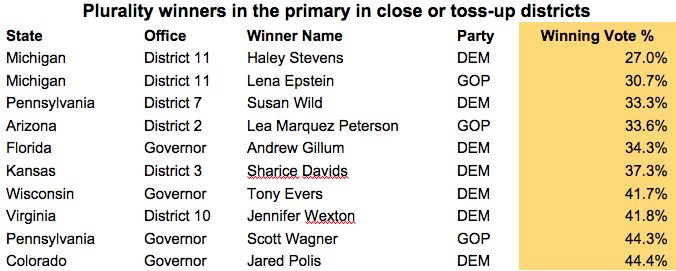OPINION: 2 Reforms Emerge to Boost Turnout, Competition After 2018 Primaries

What are the main take-aways from the 2018 primary season from an election reform perspective? In summary, some good news, some problems, and some emerging solutions.
The good news is that competition and participation both increased significantly in 2018, as more people ran, more people voted, and more primaries actually offered choice to voters. The number of candidates seeking office jumped by 30% compared with 2016, and the percent of primaries that were contested also rose significantly, particular for House races (see charts below).
More competition contributed to a major increase in turnout, as thirteen million more people voted than in the last non-presidential-year primary. Turnout rose to approximately 18 percent of registered voters this year, up from thirteen percent in 2014.
Source: Ballotpedia
But there’s bad news here as well. First, 18% voter turnout and 23% of primaries contested are still dismal, still indicative of a breakdown in the connection between citizens and representatives fundamental to democracy. At the state legislative level, less than 20% of primaries across the country offered any choice to voters at all.
Second, races that did feature more competition often ran into the shortcomings of the simple plurality election system still used in most districts, in which the candidate with the most votes wins, regardless of whether that candidate has majority support.
In crowded races, simple plurality rules often result in winners with low percentages of the vote, who may not be preferred by, or even in step with, the majority. Primary season closed with several dramatic examples of a low plurality winners, including Lori Trahan’s victory with 21.6% of the vote in a ten-candidate field in the Massachusetts 3rd Congressional district.

Of all the primaries this year for House, Senate and state-wide offices, 117 resulted in plurality winners, including 34 primaries won with less than 35% of the vote. The chart to the left, focused on just the House, illustrates the significant increase in plurality primary winners, with 86 this year nearly doubling the average of the prior three elections.
30% of the races this fall that are key to control of the House (those ranked as “toss up” or “lean” by the Cook Political Report) include at least one candidate who won in the primary without majority support.
Which brings us to the emerging solutions: election reforms moved forward this season that address both of these problems, anti-gerrymandering reform, which can finally give us more of the competition voters deserve, and ranked choice voting, which replaces simple plurality with a ranked ballot and instant runoff tabulation that together ensure a winner supported by the majority.
Ranked choice voting performed flawlessly in its first state-wide test, in the Maine primaries in June, and also won a resounding revote of confidence from Mainers, who were required to overturn a state legislative repeal of the reform. In parallel, state constitutional amendments to replace state-legislator-managed redistricting with more independent processes won in Ohio and moved forward to the November ballot in Colorado, Michigan, Utah, and possibly Missouri.
What’s interesting about these two reforms is the way they depend upon each other and reinforce each other. The goal of anti-gerrymandering is in part to end the practice of drawing “safe seat” districts for incumbents, a change that should put a higher percentage of Congressional and state legislative seats in play each cycle. But more competition without a system like ranked choice voting increases the likelihood of divisive and unrepresentative results. Likewise, advances in ranked choice voting without redistricting reform may have limited impact because in many states few races have more than two candidates.
Gerrymandering is certainly much more widely known and understood as a significant threat to our democracy, but ranked choice is gaining mindshare. Ranked choice advocates often emphasize that the system removes the “spoiler” problem for supporters of independent and third party candidates and reduces the returns to negative campaigning. Two other attributes get less airtime but are also important.
First, crowded simple plurality primaries can cost political parties seats in the general election, if a more extreme candidate wins a plurality victory over a more electable alternative. In November, the Governor’s race in normally red Kansas will be in play because the controversial Kris Kobach won a seven candidate primary with 40.6% of the vote. Likewise, the Virginia GOP presumably lost a viable chance at a Senate seat when “neo-confederate” Corey Stewart beat Nick Freitas 44.9 to 43.1 in a three way primary. Stewart is predicted to lose badly, while Freitas is leading the charge in the Virginia state legislature for ranked choice voting so future multiple-candidate races reflect the will of the majority.
The chart below lists other close races to watch in November with a plurality primary winner on one or both sides.

Another less publicized attribute of ranked choice voting is its potential to reduce extremism in office.
Research conducted by Election Reformers Network (ERN) indicates that candidates who win plurality victories in the primary and then go on to Congress tend to have more extreme voting records. Using a political science scale called NOMINATE score that measures roll call voting on a spectrum from very liberal (negative 1) to very conservative (positive 1), ERN found that the average NOMINATE score of House members who had entered Congress after winning a primary with a low plurality result was nearly a third higher than for House members who won with a majority (see chart below).

In this election year of such an encouraging, though incomplete, increase in participation and competition, 95 House and Senate candidates are headed to the general election in November without the backing of the majority of primary voters in their district. A significant percentage are in districts that lean toward their party, meaning likely victory in November. If prior patterns hold, they will vote more extreme on average than their colleagues that won with majorities, which is another good reason why we need to combine the increase in competition from anti-gerrymandering reform with the majoritarian and consensus-supporting benefit of ranked choice voting.
Photo Credit: Rob Crandall / shutterstock.com




